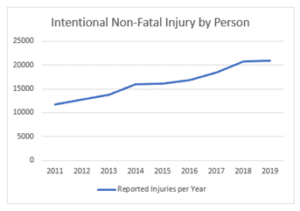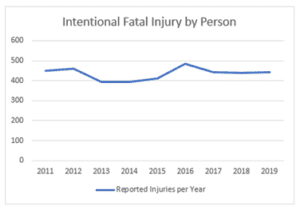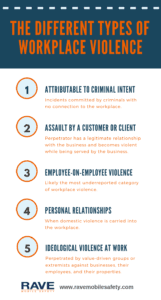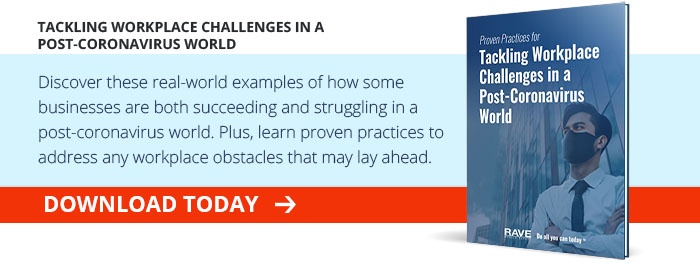Le point sur les statistiques relatives à la violence sur le lieu de travail
Updated 2/9/2021—The latest on workplace violence statistics for 2021 is that despite the COVID-19 pandemic many federal agencies have been able to publish figures relating to fatal and non-fatal injuries at work; and from these figures it has been possible for health and safety experts to extract statistics relating to workplace violence.
Comparing these statistics with other sources of data, it is clear many businesses continue to under-report non-fatal injuries and illnesses at work. This under-reporting creates a misleading picture of violence in the workplace and – due to not acknowledging the issue – results in businesses failing to adequately protect employees.
The discrepancy between reported workplace violence and unreported workplace violence is expected to worsen when statistics for 2020 are produced. Despite many employees working remotely in the relative safety of their homes, those who have continued to work on-site during the pandemic have faced increasing levels of violence.
According to Bloomberg Law, public-facing employees have been screamed at, spat on, and assaulted for trying to enforce mask-wearing rules and, in November, we reported on how a Family Dollar security guard had been shot and killed for trying to enforce mask-wearing rules. It is doubtful many of the non-fatal incidents will appear in official workplace violence statistics.
Office workers have also been subject to COVID-19-related workplace violence. According to HR Daily Advisor, the stress of the pandemic has raised stressed levels and lowered thresholds for confrontation over previously non-existent issues such as social distancing and hand hygiene. Again, we´ll likely never know how many confrontations escalated into workplace violence.
The Scale of Under-Reporting is Widely Acknowledged
The under-reporting of workplace injuries and workplace violence is not a new phenomenon. In 2014, the American Journal of Industrial Medicine published a report in which it found 90% of surveyed organizations were not complying with Occupational Safety and Health Administration (OSHA) reporting regulations. The following year, NSC Injury Facts claimed large discrepancies existed between the number of reported injuries and the number of worker compensation claims.
In 2016, OSHA attempted to address the scale of under-reporting by issuing a Final Rule affecting the electronic reporting of injuries. Unfortunately, the Rule did not have the desired effect. In 2018, the Office of the Inspector General noted one of the top performance challenges facing the U.S. Department of Labor was how the department could best use its resources to help protect workers’ safety and health, but the challenge was exacerbated by the underreporting of workplace injuries.
OSHA´s electronic reporting rule was one of several employer accountability rules subsequently rolled back by the Trump administration, and there continue to be multiple reports in the media about the scale of workplace violence and the failure of businesses to protect employees from avoidable injuries – either because they are not aware of the scale of under-reporting, or because they are not legally compelled to do anything about it.
In this blog we will cover:
- Why is Violence at Work Under-reported?
- How Violence at Work is Defined
- The Most Dangerous Profession to Work in is Healthcare
- Measures to Prevent Workplace Violence
- Are Employers Failing to Prioritize Workplace Safety?
- Workplace Violence Statistics Demographics
- Other Workplace Violence Takeaways from Around the Web
- Workplace Violence Financial Data
- Workplace Shootings, Active Shooters
- FAQs
Why is Violence at Work Under-reported?
There are various reasons why violence at work is under-reported. The American Journal of Industrial Medicine report referenced above concluded businesses fail to report non-fatal injuries due to a lack of awareness, a lack of communication, and a lack of incentive. Due to the time it takes to complete Survey of Occupational Injury and Illness (SOII) reports, many businesses use whatever data is available at the time rather than implement accurate data collection and reporting processes.
However, around the same time as NSC Injury Facts was raising its concerns about under-reporting, Carol Fredrickson – a specialist in workplace conflict resolution – published her “7 Reasons Employees Don’t Report Workplace Violence”. The list relates exclusively to employee-on-employee violence but concludes with a point exceptionally pertinent to the latest workplace violence statistics – many employees and employers do not understand how violence at work is defined.
How Violence at Work is Defined
According to the Workplace Violence Research Institute, workplace violence has two definitions. The first, the Institute claims, is one perpetrated by the media in which a disgruntled customer or employee takes a firearm to a place of work and shoots indiscriminately. Although an exaggerated example, this definition may explain why many employees and employers feel violence at work only occurs when an injury is sustained due to a physical attack.
The second definition is one more closely aligned to that provided by OSHA. The Administration’s website states: “Workplace violence is any act or threat of physical violence, harassment, intimidation, or other threatening disruptive behavior that occurs at the work site. It ranges from threats and verbal abuse to physical assaults and even homicide.” According to the latest workplace violence statistics released by the National Safety Council, physical assaults in the workplace resulted in 20,870 injuries and 454 fatalities in 2019.
The Most Dangerous Profession to Work in is Healthcare
In 2016, the New England Journal of Medicine published a comprehensive review of “Workplace Violence against Health Care Workers in the United States”. The review included data from the Bureau of Labor Statistics showing healthcare workers are nearly four times as likely to require time away from work as a result of violence as they are because of other types of injury (the most common being back injuries, needle stick injuries, exposure to blood and body fluid, and smoke inhalation).
The review also reported that, although employees in the healthcare and social assistance sectors account for 12.2% of the working population (and despite there being the potential for under-reporting in other industries), nearly 75% of workplace assaults occurred in a healthcare setting.
Among other recent workplace violence incidents:
- 80% of Emergency Medical Services personnel have been attacked by patients.
- Homicide is the second leading cause of workplace death for home healthcare workers.
- 78% of Emergency Department physicians and 100% of Emergency Department nurses have experienced violence from patients within the last year.
- The annual incidence of physical assault in a psychiatric setting is 70%.
- Among nursing homes with dementia units, 59% of nursing aides reported being assaulted by patients weekly and 16% daily.
- 46% of nurses reported some form of workplace violence during their five most recent shifts.
Among workplace shootings 2018-2019, it is worth noting that only four of the hospital shootings were included in the FBI’s “Active Shooter Study” published in 2018. This is because the majority took place on hospital grounds, while those that took place inside an Emergency Department or on a ward were the result of the shooter removing a firearm from a security guard or law enforcement officer. This is another example of how the latest workplace violence statistics can create a misleading picture of violence in the workplace.
Among workplace shootings 2018-2019, it is worth noting that only four of the hospital shootings were included in the FBI’s “Active Shooter Study” published in 2018. This is because the majority took place on hospital grounds, while those that took place inside an Emergency Department or on a ward were the result of the shooter removing a firearm from a security guard or law enforcement officer. This is another example of how the latest workplace violence statistics can create a misleading picture of violence in the workplace.
Measures to Prevent Workplace Violence
There are various measures that can be implemented to prevent workplace violence cases. The first is for employers to understand the OSHA definition of violence at work and implement policies that protect employees from the “threat of physical violence, harassment, intimidation, or other threatening disruptive behavior that occurs at the work site”. Should these events occur, the policies must be enforced, sanctions applied, and the incidents included on the SOII reports.
In circumstances where employees are at risk from physical assault, employers should implement mechanisms that can quickly alert security personnel and emergency services to an act of violence. According to our “Trends in Corporate Security Report” approximately 25% of businesses are unprepared for an active shooter incident, meaning the incident is frequently over before police respond and arrive at the scene.
Are Employers Failing to Prioritize Workplace Safety?
In our 2019-2020 Workplace Safety and Preparedness Report, 30% of respondents said they were unaware or unsure of their employers’ Emergency Preparedness Plans for the most common types of workplace emergencies. Higher percentages reported that although Emergency Preparedness Plans existed for severe weather events, medical emergencies, and system outages/cyberattacks, the plans were rarely or never tested.
This doesn’t necessarily imply employers are failing to prioritize workplace safety. It’s more likely their efforts are being focused in the wrong areas due to regulations requiring events such as the periodic testing of fire alarms and fire drill procedures. However, it was particularly noted in the report that more than a third of female respondents were unaware of workplace violence emergency plans, despite workplace violence being the second leading cause of death for women in the workplace.
Workplace Violence Statistics Demographics
Each year, the National Safety Council release an “Injury Facts” report revealing the number of injuries and days lost due to workplace assaults. By analyzing the source data from the Bureau of Labor Statistics (BLS), it is possible to identify specific trends in workplace violence statistics – with the caveat that some trends may be attributable to the increased reporting of non-fatal injuries.
Non-Fatal Injuries


Fatal Injuries


What these bare workplace fatality statistics don’t reveal is the unequal distribution by gender. In 2017, homicides accounted for 22% of fatal injury events for women, but only 8% of fatal injury events for men. Of the 441 workplace homicides in 2017, co-workers were responsible for 77 deaths, customers for 51 deaths, and relatives for 28 deaths. The remainder were attributable to outside actors.

Most Dangerous States to Work In
Because California, Texas, Florida, and New York have larger working populations than other states, there are naturally more accidents in these states. However, this does not mean they are the most dangerous states to work in. Our analysis of BLS data sorted states by their relative sizes and the number of accidents in each to determine which the ten most dangerous states to work in actually are.

Other Workplace Violence Takeaways from Around the Web
– The healthcare industry makes up 9% of the U.S. workforce, yet healthcare professionals experience more workplace violence injuries than all other industries combined
– Out of all 7 possible causes of death at the workplace, homicides make up 9%
– The third leading cause of death for workers in the healthcare and professional services industries (education, law and media) is due to workplace violence
– More on education: 44% of teachers reported being physically attacked while at school within one year
– Employees with potential to commit workplace violence tend to exhibit 8 behaviors such as acting out of character or exhibiting addictive habits
– The two most common traits when it comes to those who commit white-collar workplace violence are narcissism and psychopathy
Workplace Violence Financial Data
– $3 or more is saved for each dollar invested in workplace safety
– $121 billion annual losses are attributed to workplace assaults
– Domestic violence issues that are brought to the workplace cost nearly $727 million in lost productivity
– Workplace catastrophes such as violent incidents have caused publicly-traded companies to lose close to 8% in shareholder value
– Lawsuits associated with workplace violence cost companies an average of $500,000 for out-of-court settlements
Workplace Shootings, Active Shooters
– Out of all mass shootings since 1966, 25% occurred at workplaces
– In 2018, there have been at least 18 mass shootings involving four or more victims, except for the suspect
– 70% of all active shooter incidents are within a commerce/business or educational setting
– 96% of active shooters are lone males
– 40% of active shooter assailants commit suicide
– Approximately 25% of companies are unprepared for active shooter incidents
– In 2014 and 2015, police exchanged gun-fire with the assailant in 14 active shooter incidents
– In nearly half of active shooter incidents, police are unable to respond under 10 minutes
– Active shooters are nearly twice as likely to die if the shooting occurs in a factory or warehouse, compared to commercial settings
– The FBI has found 10 key behaviors in active shooter assailants, including a mental health history and the decision to choose to attack familiar places
– Copycat active shooter events often happen in clusters, with the risk of an active shooter in the workplace at its highest in the two weeks following a similar incident
FAQs
Is bullying considered to be workplace violence?
Bullying – either by a colleague or an employer – was acknowledged as an act of workplace violence by the U.S. Office of Personnel Management in 1998. In the publication “Dealing with Workplace Violence” (PDF), the agency notes that not only can bullying be a form of intimidation, it can also be an indicator of potentially violent physical behavior.
Is there protection against retaliation when you report workplace violence?
An employer should have policies in place to protect employees who report workplace violence from retaliation. If an employer fails to protect an employee from retaliation – or is the perpetrator of the workplace violence – OSHA operates a whistleblower protection program and has previously taken employers to court for retaliating against employees.
What is indirect workplace violence?
Workplace violence doesn´t necessarily have to be physical or verbal. Online harassment via email, text, or chat apps is also considered to be workplace violence, even when the perpetrator does not communicate directly with the victim – for example spreading false gossip about an individual by mass email or social media.
What is “Quid pro Quo” sexual harassment?
Quid pro quo translates as “this for that”, and the term relates to any form of harassment in which something of value is offered in return for a “favor”. While a victim of quid pro quo can benefit from this type of workplace violence, the potential exists for the victim to be subsequently blackmailed to keep the something of value offered to them (i.e. a promotion).
Are lone workers more likely to be victims of workplace violence?
While there is no data to suggest lone workers are more or less likely to be victims of workplace violence, it is certainly the case they are more vulnerable – especially during the early morning or late evening. Employers should conduct risk assessments and implement measures to reduce the likelihood of a lone worker becoming a victim of workplace violence.
Within what timescale must an incident of workplace violence be reported?
While the length of time allowed for reporting workplace violence varies according to workplace policies, workplace violence that results in a fatality must be reported to OSHA within 8 hours, and inpatient hospitalizations within 24 hours. With regards to reporting retaliation to OSHA, the time limit is 30 days after the retaliatory event.
What is a workplace violence app?
A workplace violence app is a mobile app that can be used by employees to anonymously report incidents to designated corporate safety leaders. Two-way messaging allows employees to submit reports along with text and images. Some workplace violence apps also have a virtual escort feature that provides additional security for employees on the clock who have to travel to different locations as part of their job.





